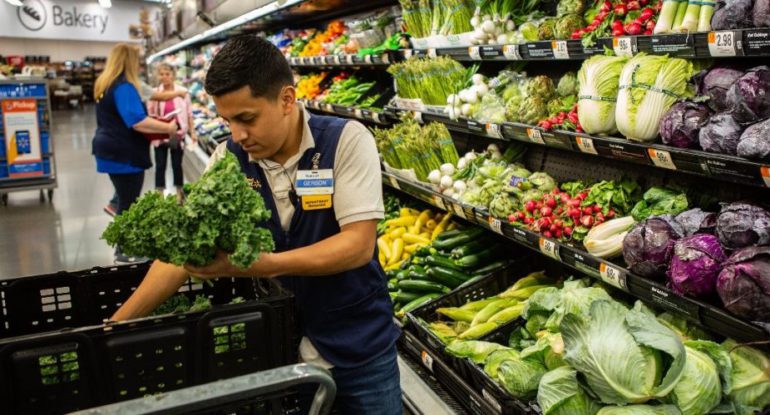In Aftermath of E. Coli Outbreak, Walmart Brings Suppliers to the Blockchain

On Monday, Walmart announced it’s requiring grocery chain suppliers who provide leafy green vegetables to submit and upload data to the Blockchain through its IBM Food Trust Network by January 31, 2019, and for other suppliers to join by the following September.
I was able to speak with Frank Yiannas, Vice-President of Food Safety at Walmart, on what this move could mean for Walmart and other grocery chains moving forward.
What Went Wrong?

Affecting more than 200 people across 36 states, E. coli had the FDA’s attention for many months, while leaving at least 96 people hospitalized and five dead. This year, we have seen an enormous increase in product recalls, specifically surrounding romaine lettuce.
#1 –Inability to Adapt to 21st Century Technology
Today’s current system of utilizing traditional paper-based methods of product identification, storage, and distribution is costly and time-consuming.
Eventually, discovering the outbreak originated out of Yuma, Arizona, it took almost seven days for the Walmart Food Safety Division to identify where the lettuce was grown.
“But, this wasn’t an issue isolated to Walmart,” Yiannas said. “Rather, it is an issue plaguing the entire industry.”
“There are many stages that the information must go through before reaching the consumer and general public,” Yiannas added. “In Walmart’s case, our Food Safety Division must contact the supplier, obtain paper records, and utilize those records to contact the specific company that imported and/or shipped that product to our distribution center.”
#2 –Inability to Recognize Harvesting Location of Goods

Not knowing where our food and/or vegetables were grown, harvested, shipped, and distributed is a major concern for public health and safety. And Walmart agrees. The recent E. coli outbreak was enough for Walmart to put its foot down, wanting to provide customers with more than just “everyday low prices.”
When the outbreak was first announced, the biggest concern for both consumers and manufacturers was recognizing which retail brands of lettuce were infected, and which weren’t. “Another concern was wasting lettuce and discarding those that weren’t affected,” Yiannas added.
“If it taught us anything, it’s that right now, we don’t know where our lettuce is grown, and we have no easy way of finding that information out,” Yiannas emphasized.
So, what does the process look like?
Step #1 [Farming]: At the farm, the lettuce is planted in a field, until fully grown;
Step #2 [Harvest]: The farmer harvests it;
Step #3 [Processing]: The head of romaine is sent to a processing facility where it is washed, sliced, and bagged;
Step #4 [Transport]: It’s transported to a distribution center, where it’s sorted and placed on trucks for delivery;
Step #5 [Arrival]: Once the grocery store receives the lettuce, associates unload it from a truck and immediately move it to a cooler where it’s then taken to the sales floor; and
Step #6 [Customer]: Finally, from the sales floor, the lettuce is either placed in a customer’s cart or selected by a customer for pickup or delivery.

Yiannas told me that the difficulty in identifying the source of the contamination was that none of the bags of salad were labeled “Yuma, Arizona.” Consequently, this makes identifying and tracing the potential origin points extremely challenging.
#3 –Lack of Education
Unfortunately, the food sector is no different from the technology sector. It’s not if an incident occurs, it’s when. In the case of public health and safety, not knowing information about food source and origin can kill.
That’s what happened in the case of the Arizona lettuce contamination.
What Can The Blockchain Do For Walmart, Its Customers, and Grocery Chains?
#1 –IBM Is A Force To Be Reckoned With
During our conversation, Yiannas and I agreed that it’s time to stop looking at how to better address post-incidents and start focusing on how to prevent them from the outset.
That’s why it has partnered with IBM, utilizing its expertise and knowledge in the blockchain space. “There’s no question that IBM is the leader when it comes to blockchain technology,” Yiannas said.
“Instead of days or weeks, we now have seconds. IBM has the technology and we have the ingredients to help fuel this for the entire industry.”
#2 –‘FedEx’ Tracking For Food
With food, there’s no leaving it to chance. Timing and accuracy can keep a person on their feet, or on a bed. By utilizing blockchain technology, Walmart’s vision is that any customer can walk up to a self-checkout unit, scan their bag of lettuce (or vegetables), and immediately see where it was harvested and distributed up and until it reached the store.
Yianna’s analogy is that this is the equivalent of FedEx tracking for food. “You will now have the ability to see each and every destination your item has been to,” he said, “up and until it reaches the Walmart distribution center.”
#3 –Simulated Education Programs For Suppliers
As for education and training programs for suppliers, Yiannas told me that they already are working on implementing programs that will be just as easy as setting up an iPhone, providing step-by-step instructions on how to submit all the required information to the Blockchain.
When it comes to food manufacturing and incident response plans, a lack of time can kill. We are in a digital age where if you’re not up to date with technology, you’re losing money and customers.
Originally posted on Forbes
All images are authorized by Walmart, Inc.
Add a comment
You must be logged in to post a comment.





























































